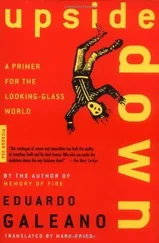The invaders call Sandino a “bandit.”
He appreciates the joke:
“So George Washington was a bandit? He fought for the same thing.”
And he appreciates the donations: Browning rifles, Thompson sub-machine guns, and all the weapons and munitions the Marines leave behind in their courageous retreats.

In 1933, the Marines, humiliated, left Nicaragua.
They left, but they remained. They had trained Anastasio Somoza and his troops to be their replacement.
And Sandino, victorious in war, was defeated in an act of treason.
He was killed in an ambush in 1934. From behind it must have been.
“You shouldn’t take death seriously,” he liked to say. “It is but a moment’s discomfort.”
Although his name was outlawed, and outlawed too was his memory, forty-five years later the Sandinistas overthrew the dictatorship of his assassin and his assassin’s children.
And then Nicaragua, little country, barefoot country, managed to commit the insolence of resisting for ten years a mad assault by the greatest military power in the world. That happened from 1979 on, thanks to those secret muscles that do not appear in any book on anatomy.
BRIEF HISTORY OF THE PROPAGATION OF DEMOCRACY IN THE AMERICAS

In 1915, the United States invaded Haiti. In the name of his government, Secretary of State Robert Lansing explained that the Negro race was incapable of governing itself, due to its “inherent tendency to revert to savagery and to cast aside the shackles of civilization, which are irksome to their physical nature.” The invaders stayed nineteen years. The leader of the Haitian patriots was nailed to a door, his arms spread out in a cross.
The occupation of Nicaragua lasted twenty-one years and led to the Somoza dictatorship, while the occupation of the Dominican Republic lasted nine years and led to the Trujillo dictatorship.
In 1954, the United States launched democracy in Guatemala with aerial bombardments that put an end to free elections and other perversions. In 1964, the generals who put an end to free elections and other perversions in Brazil received money, weapons, oil, and congratulations from the White House. Something similar occurred in Bolivia, where one studious fellow came to the conclusion that no coup d’état ever occurs in the United States because it has no U.S. Embassy.
That lesson was confirmed when General Augusto Pinochet answered Henry Kissinger’s cry of alarm and kept Chile from “going communist due to the irresponsibility of its own people.”
Around the same time, the United States bombed three thousand poor Panamanians in order to capture a disgruntled former employee, sent troops to Santo Domingo to frustrate the return of a democratically elected president, and had no choice but to attack Nicaragua to keep Nicaragua from invading the United States through Texas.
At that point, Cuba had already received the affectionate visit of airplanes, ships, bombs, mercenaries, and millionaires sent on a pedagogic mission from Washington. They got no farther than the Bay of Pigs.

Charlie the Tramp picks up a red rag fallen to the pavement from the back of a passing truck. He waves it and shouts to the driver just as a demonstration of workers marches up behind him, and suddenly, without knowing why, he finds himself being chased and beaten by the police.
Modern Times is the last movie that stars this character. And Chaplin, his father, is bidding adieu not only to his loveable creation, but also to silent film.
The movie does not merit a single Oscar nomination. Hollywood does not care one bit for the disagreeable pertinence of the subject matter, the epic of the little guy trapped in the gears of the industrial era in the years following the Crash of 1929.
A tragedy that evokes laughter, an implacable and moving portrait of the times: machines eat people and steal jobs, the human hand is indistinguishable from other tools, and the workers, who imitate machines, do not get sick, they rust.
At the beginning of the nineteenth century, Lord Byron had already concluded:
“It is easier now to manufacture people than machines.”

People who were physically, mentally, or morally abnormal, murderers, the depraved, imbeciles, crazies, masturbators, drunks, vagrants, beggars, and prostitutes were all lying in wait for their chance to plant a bad seed in the virtuous earth of the United States.
In 1907, the state of Indiana became the first place in the world where the law authorized compulsory sterilization.
By 1942, forty thousand patients in the public hospitals of twenty-eight states had been sterilized against their will. All of them poor or very poor, many of them black, a few Puerto Rican, not a few Native American.
The letters that poured in to the Human Betterment Foundation, a charitable organization dedicated to saving the species, pleaded for assistance. One college student told of being on the point of marrying a young man who appeared normal, but his ears were too small and they looked a bit like they were on upside down:
“I have been advised by a physician that if we have children it may result in something degenerate.”
An extremely tall couple asked for help:
“We do not wish to bring abnormally tall children into the world.”
In a letter dated June 1941, another college student said that a class-mate was retarded and that she turned her in because she might give birth to idiots.
Harry Laughlin, the foundation’s ideological inspiration, received an honorary doctorate in 1936 from the University of Heidelberg for his contribution to the Reich’s campaign for racial hygiene.
Laughlin was obsessed with epileptics. He maintained they were the equivalent of the retarded but more dangerous, and that there was no place for them in a normal society. Hitler’s “Law for the Prevention of Defective Progeny” imposed obligatory sterilization on the retarded, schizophrenics, manic depressives, the physically deformed, the deaf, the blind. . and epileptics.
Laughlin himself was epileptic. No one knew.

In 1935, the “Law for the Protection of German Blood and Honor,” and other laws brought in simultaneously, laid the foundation for a national identity based on biology.
Anyone who had Jewish blood, even a few drops, could not be a German citizen or marry a German citizen.
According to the authorities, the Jews were not Jews because of their religion or their language, but because of their race. It was not an easy distinction to define. Nazi experts found inspiration in the bountiful history of racism in the world, and they relied on the invaluable assistance of the company IBM.
Engineers at IBM designed forms and perforated cards to record the physical characteristics and genetic history of every person. And they set up a far-reaching high-speed automated system for identifying complete Jews, half-Jews, and those who had more than a sixteenth part Jewish blood circulating in their veins.
SOCIAL HYGIENE, RACIAL PURITY

Читать дальше


















